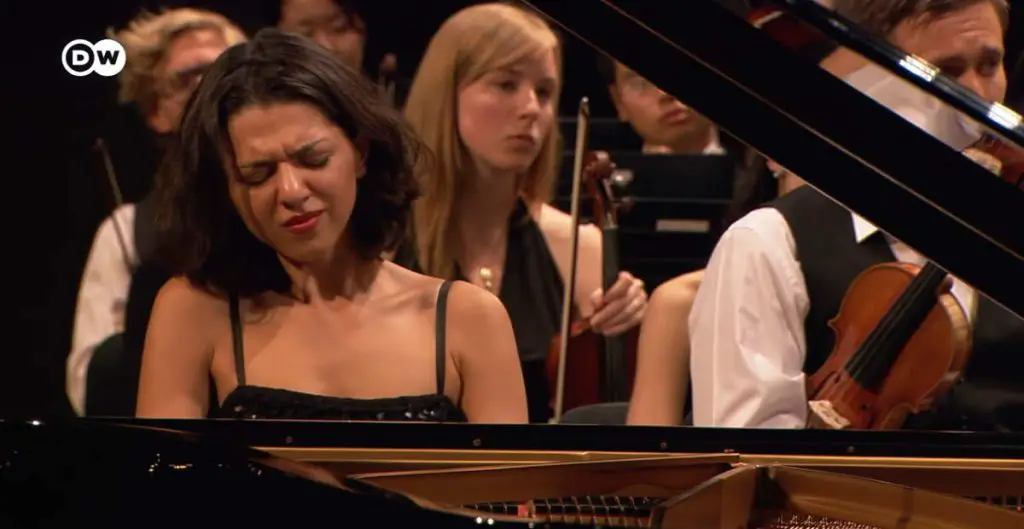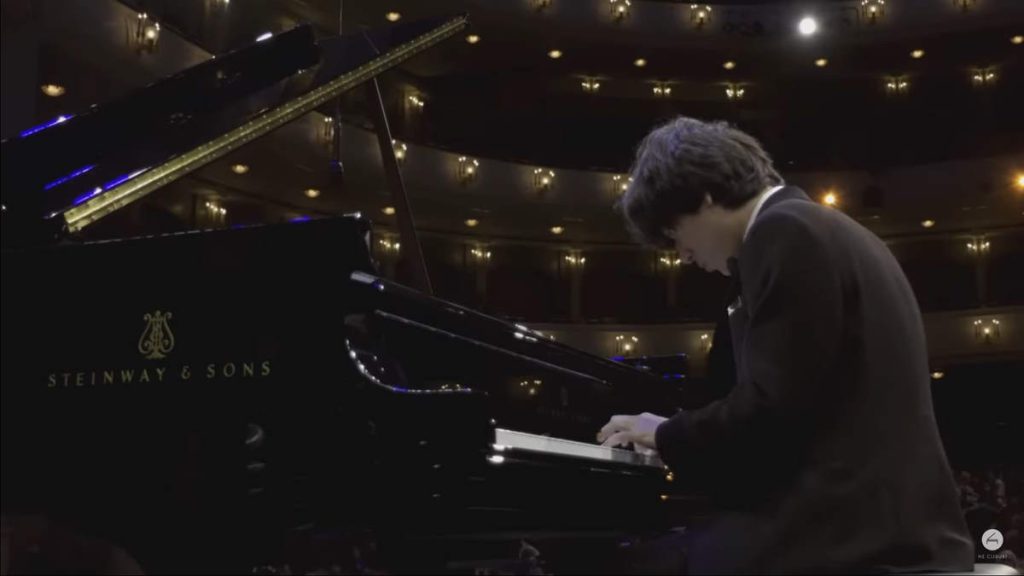Accompanied by the New York Philharmonic Orchestra, the legendary pianist Vladimir Horowitz plays Sergei Rachmaninoff’s Piano Concerto No. 3 in D minor, Op. 30. Conductor: Zubin Mehta, another legend. This 1978 recording is the last ever of Horowitz playing Rachmaninoff’s Piano Concerto No. 3, and maybe the last time he played it. He was 75 years old in this recording.
Rachmaninoff’s Piano Concerto No. 3
Rachmaninoff’s Piano Concerto No. 3 in D minor, Op. 30, is one of the most demanding and celebrated works in the piano repertoire. Composed in 1909, it was written for Rachmaninoff’s first concert tour of the United States. The composer himself premiered it in New York with the New York Symphony Society under Walter Damrosch, and later performed it with Gustav Mahler conducting the New York Philharmonic – an experience Rachmaninoff greatly admired for Mahler’s meticulous preparation.
Often referred to simply as “Rach 3,” the concerto has a reputation for extreme technical difficulty. Its challenges are not merely about speed or power; the writing demands endurance, wide hand spans, precise articulation in dense textures, and a capacity to project lyrical lines over massive orchestral forces. Pianists must navigate complex chordal passages, intricate counterpoint, and sweeping arpeggios, often at breakneck tempos, without sacrificing musical expression.
Despite this virtuosity, the concerto is deeply melodic. Rachmaninoff’s gift for long-breathed, singing lines permeates the work, and the music alternates between introspective, almost nostalgic lyricism and thunderous, dramatic outbursts. The piano is fully integrated into the orchestral fabric, not just as a soloist delivering flourishes, but as a partner engaged in a rich musical dialogue with the ensemble. The orchestration, while lush, is carefully balanced to allow the piano’s voice to shine through.
The work’s emotional arc is vast, moving from moments of serene intimacy to passages of monumental grandeur. The harmonic language blends Romantic warmth with subtle chromaticism, creating a sound world that is unmistakably Rachmaninoff’s. Beneath the surface, the piece reflects the composer’s Russian heritage – not in direct folk quotations, but in its expansive melodic shapes, deep sonorities, and expressive intensity.
Piano Concerto No. 3 also has a special place in cultural history. While it enjoyed success in Rachmaninoff’s lifetime, it gained legendary status in the later 20th century through performances by pianists such as Vladimir Horowitz, Van Cliburn, and Martha Argerich. Its reputation was further cemented when it featured prominently in the 1996 film Shine, bringing its ferocious technical challenges – and emotional depth – to a wider audience.
Today, “Rach 3” is considered a pinnacle for concert pianists. To master it is a badge of honor, requiring not just technical brilliance but profound musical insight. It remains a thrilling experience for audiences and performers alike, combining virtuosic spectacle with some of the most heartfelt and expansive melodies in the piano concerto repertoire.
Movements
1. Allegro ma non-tanto (D minor)
The first movement of Rachmaninoff’s Piano Concerto No. 3, marked Allegro ma non-tanto, begins with a deceptively simple, almost understated theme introduced by the piano alone. Unlike the grand openings of many Romantic concertos, Rachmaninoff opts for a quiet, flowing melody in a modest register, accompanied by light orchestral support. This theme, built from small stepwise intervals, has an almost chant-like quality – some have speculated it was influenced by Russian liturgical music, though Rachmaninoff denied using an actual church melody.
From this serene opening, the music gradually builds in scope and complexity. The piano soon begins to elaborate the theme, weaving intricate figurations around it while the orchestra enriches the harmonic and dynamic palette. The movement follows a broadly sonata-allegro structure, with a lyrical second theme that provides contrast through warmer harmonies and more expansive phrasing.
The development section is where the movement’s technical challenges fully emerge. The piano part becomes increasingly virtuosic, with rapid passagework, double notes, wide leaps, and dense chordal textures. One of the movement’s most famous hurdles comes in the massive cadenza. Rachmaninoff actually wrote two versions: the original “light” cadenza, flowing and intricate, and an alternative “ossia” cadenza, which is even more monumental, featuring towering chordal sequences and demanding enormous physical power from the pianist. Most performers choose the ossia for its sheer dramatic impact.
Following the cadenza, the recapitulation restates the main themes with heightened intensity, leading to a thrilling conclusion. The ending is not bombastic, but resolute – a firm orchestral statement with the piano still intricately involved.
Overall, the first movement balances intimacy and grandeur, lyrical beauty and virtuosic firepower. It sets the tone for the concerto’s blend of Russian romanticism, structural mastery, and pianistic brilliance, challenging the soloist to maintain both musical clarity and emotional depth amid formidable technical demands.
2. Intermezzo: Adagio (F sharp minor/D flat major)
The second movement of Rachmaninoff’s Piano Concerto No. 3, marked Intermezzo: Adagio, offers a lyrical and reflective contrast to the intensity of the first movement. It opens with a warm, songlike theme in the orchestra, led by the winds and strings, setting a mood of gentle melancholy. The piano soon enters, not with fireworks, but with delicate, expressive commentary, intertwining gracefully with the orchestral lines rather than dominating them.
The movement has a ternary (ABA) structure, though Rachmaninoff enriches it with fluid transitions and thematic transformations. In the opening section, the piano often plays in a chamber-like texture, echoing and embellishing the orchestral melodies. The harmonies shift subtly, creating a dreamlike atmosphere that is both tender and tinged with longing.
The contrasting middle section is more animated and rhythmically driven. Here, the piano takes on a more assertive role, with cascading passagework and playful exchanges with the orchestra. The mood becomes brighter, even dance-like in places, yet retains Rachmaninoff’s characteristic lushness. Within this livelier interlude, fragments of the opening movement’s material make a brief, almost hidden return, providing a thematic link across the concerto.
When the opening theme returns, it is more ornamented and harmonically enriched, giving a sense of emotional deepening rather than simple repetition. The piano’s filigree lines float above the orchestral accompaniment, as if suspended in midair. The movement closes quietly and poetically, fading into a calm stillness – a moment of repose before the storm of the finale.
This movement showcases Rachmaninoff’s gift for lyricism and his skill at balancing the piano and orchestra in a true partnership. It demands not only technical control but also the ability to shape long, singing lines and convey deep emotional nuance, making it one of the concerto’s most intimate and poignant moments.
3. Finale: Alla breve (D minor → D major)
The third movement of Rachmaninoff’s Piano Concerto No. 3, marked Finale: Alla breve, bursts in without pause, following directly from the gentle close of the second movement. The transition is seamless, but the energy shift is immediate – the piano launches into rapid, bright passagework, and the orchestra joins with rhythmic drive. The main theme, assertive and full of momentum, sets a tone of determined forward motion.
Structurally, the movement follows a broad sonata-rondo form, allowing Rachmaninoff to alternate recurring themes with contrasting episodes. The first theme is vigorous and percussive, often doubled by the orchestra, while the second theme is broader and more lyrical, offering brief moments of relief from the intensity. Both themes are subjected to continuous development, with the piano frequently engaging in dazzling runs, arpeggios, and massive chordal sequences.
One of the hallmarks of this finale is its sheer physical demand on the pianist. The writing combines relentless speed with intricate figuration, wide leaps, and constant shifts between delicate ornamentation and thunderous climaxes. Rachmaninoff’s integration of the piano and orchestra remains tight – the soloist is never simply showing off, but pushing the music’s momentum forward in partnership with the ensemble.
Midway through, a more expansive section recalls thematic material from the first movement, creating a sense of unity across the concerto. This reminiscence is not a literal repeat, but a transformation – richer in harmony and more dramatic in tone. The pace then accelerates toward a monumental coda, where the piano and orchestra unleash their full power.
The concerto ends in a blaze of D major, with a jubilant, almost triumphant affirmation that contrasts sharply with the introspective opening of the first movement. It is a finale of relentless energy, technical brilliance, and emotional sweep – a fitting culmination for one of the most formidable and exhilarating concertos ever written.
Sources
- Piano Concerto No. 3 (Rachmaninoff) on Wikipedia
- “Rachmaninoff: Piano Concerto No. 3” on the Royal Concertgebouw Orchestra’s website
- Piano Concerto No. 3 in D Minor, Op. 30: musical composition by Rachmaninoff on the Encyclopedia Britannica website


